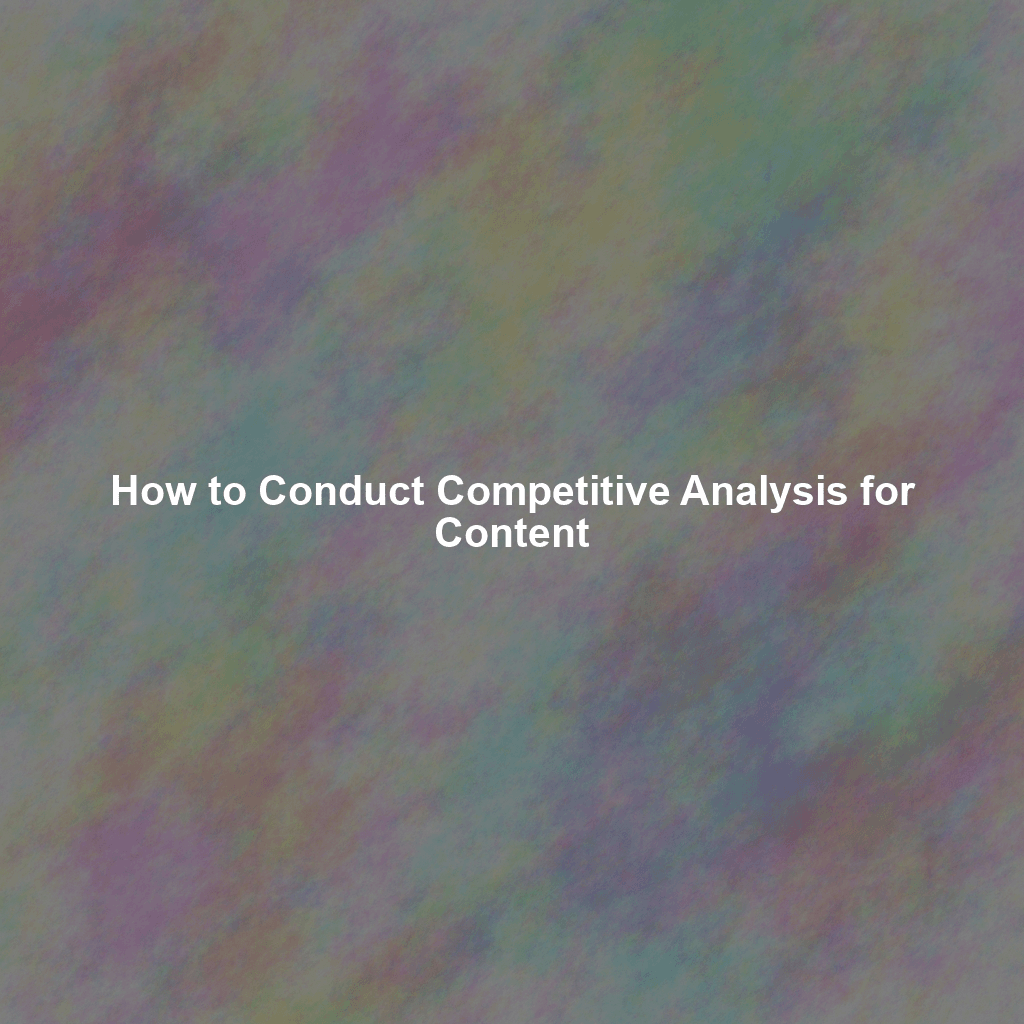Unleash Your Content Potential: Mastering the Art of Content Competitive Analysis
In the dynamic world of content marketing, creating exceptional content isn’t enough. To truly stand out and achieve your goals, you need to understand what your competitors are doing, identify opportunities, and strategically position yourself for success. That’s where content competitive analysis comes in. Think of it as your secret weapon, providing invaluable insights to sharpen your content strategy and dominate your niche.
Why Bother with Content Competitive Analysis?
Skipping competitive analysis is like navigating unfamiliar territory without a map. You might stumble upon success, but you’re more likely to waste time, resources, and effort on strategies that don’t resonate with your audience or differentiate you from the pack. Here’s why it’s a crucial element of effective content marketing:
- Identify Content Gaps: Discover topics and formats your competitors aren’t covering, allowing you to fill the void and attract a wider audience.
- Uncover Keyword Opportunities: Learn which keywords your competitors are ranking for and identify new keywords you can target to improve your search engine visibility.
- Understand Audience Preferences: Analyze what content resonates with your target audience by studying your competitors’ most popular pieces.
- Improve Content Quality: Evaluate the strengths and weaknesses of your competitors’ content to identify areas where you can improve your own quality and provide more value.
- Refine Your Content Strategy: Use competitive insights to inform your content calendar, optimize your distribution channels, and measure the effectiveness of your efforts.
- Stay Ahead of Trends: Monitor your competitors’ content to stay informed about industry trends and emerging topics, ensuring your content remains relevant and engaging.
Step-by-Step Guide to Conducting Content Competitive Analysis
Ready to dive in? Follow these steps to conduct a comprehensive content competitive analysis that will empower your content strategy:
1. Identify Your Competitors
This might seem obvious, but it’s essential to go beyond simply listing your direct business competitors. Consider:
- Direct Competitors: Businesses offering similar products or services to the same target audience.
- Indirect Competitors: Businesses offering different products or services that solve the same problem or fulfill the same need.
- Content Competitors: Websites or blogs that create content on similar topics, even if they don’t directly compete with your business.
Use tools like Google Search, industry directories, and social media to identify a comprehensive list of competitors. Aim for a manageable number (5-10) to focus your analysis.
2. Define Your Content Goals
Before you start analyzing your competitors, clarify your own content goals. What are you trying to achieve with your content marketing efforts? Are you aiming to:
- Increase brand awareness?
- Generate leads?
- Drive website traffic?
- Improve search engine rankings?
- Establish thought leadership?
Having clear goals will help you focus your analysis on the competitive insights that are most relevant to your needs.
3. Analyze Their Content Strategy
This is where the real work begins! Systematically analyze your competitors’ content strategy by examining the following aspects:
a. Content Topics and Themes
What topics are they consistently covering? Are there any recurring themes or areas of focus? Use a spreadsheet or document to track the topics each competitor is covering. Look for patterns and gaps.
b. Content Formats
What types of content are they creating? Blogs, videos, infographics, podcasts, e-books, case studies, webinars? Analyze the popularity of different formats. Are videos performing better than blog posts for certain topics?
c. Content Frequency and Publishing Schedule
How often are they publishing new content? What days of the week and times of day do they typically publish? Understanding their publishing cadence can help you determine how much content you need to produce to stay competitive.
d. Tone and Voice
What is their overall tone and voice? Formal, informal, humorous, educational? How do they connect with their audience? Do they use specific language or jargon?
e. Content Promotion and Distribution Channels
Where are they promoting their content? Social media, email marketing, paid advertising, guest blogging? Analyze their social media presence (engagement rates, followers, hashtags) and identify the most effective distribution channels for their content.
4. Conduct Keyword Research
Understanding the keywords your competitors are targeting is essential for improving your SEO and attracting more organic traffic. Use keyword research tools like SEMrush, Ahrefs, or Moz Keyword Explorer to:
- Identify the keywords they are ranking for: See which keywords are driving traffic to their website.
- Find keyword gaps: Discover keywords that are relevant to your business but your competitors aren’t targeting.
- Analyze keyword difficulty: Assess the competitiveness of different keywords to prioritize those that are easier to rank for.
- Explore long-tail keywords: Identify specific, long-tail keywords that can attract highly targeted traffic.
Focus on keywords that align with your content goals and target audience. Use these keywords strategically in your content titles, headings, and body copy.
5. Analyze Content Performance
Evaluate the performance of your competitors’ content to identify what resonates with their audience. Look at metrics such as:
- Social Shares: How many times has their content been shared on social media?
- Comments: How many comments are they receiving on their blog posts or social media updates?
- Backlinks: How many websites are linking to their content? Backlinks are a strong indicator of authority and relevance.
- Website Traffic: Estimate the traffic their content is generating using tools like SimilarWeb or SEMrush.
Pay attention to the content that is generating the most engagement and traffic. What makes it so successful? What can you learn from it?
6. Identify Content Gaps and Opportunities
After conducting your analysis, you should have a clear understanding of your competitors’ content strategy, their strengths and weaknesses, and the keywords they are targeting. Now, it’s time to identify content gaps and opportunities.
Look for:
- Untapped Topics: Are there any topics that your competitors aren’t covering but are relevant to your audience?
- Underperforming Content: Are there any areas where your competitors’ content is weak or outdated?
- Format Opportunities: Are there any content formats that your competitors aren’t using effectively?
- Keyword Opportunities: Are there any keywords that your competitors aren’t targeting?
By identifying these gaps and opportunities, you can create content that fills a need in the market and differentiates you from the competition.
7. Document and Share Your Findings
Don’t let all your hard work go to waste! Document your findings in a clear and concise report that you can share with your team. Include:
- A summary of your competitors’ content strategies.
- A list of the keywords they are targeting.
- An analysis of their content performance.
- A list of content gaps and opportunities.
- Recommendations for improving your own content strategy.
Sharing your findings with your team will ensure that everyone is on the same page and working towards the same goals.
8. Implement and Iterate
The final step is to implement your findings and iterate on your content strategy. Use the insights you gained from your competitive analysis to:
- Create high-quality content that addresses the gaps and opportunities you identified.
- Optimize your content for the keywords you are targeting.
- Promote your content through the most effective distribution channels.
- Track your results and make adjustments as needed.
Content competitive analysis is an ongoing process. Regularly monitor your competitors’ content and adapt your strategy as needed to stay ahead of the curve.
Tools for Content Competitive Analysis
There are a variety of tools available to help you conduct content competitive analysis, including:
- SEMrush: A comprehensive SEO tool that offers keyword research, competitor analysis, and website traffic analysis (SEMrush.com).
- Ahrefs: Another popular SEO tool that provides backlink analysis, keyword research, and content gap analysis (Ahrefs.com).
- Moz Keyword Explorer: A keyword research tool that helps you find the best keywords to target for your content (Moz.com).
- BuzzSumo: A content marketing tool that helps you discover the most shared content on a particular topic (BuzzSumo.com).
- SimilarWeb: A website traffic analysis tool that provides insights into your competitors’ website traffic and audience demographics (SimilarWeb.com).
- Google Alerts: A free tool that allows you to track mentions of your competitors and industry keywords (Google.com/alerts).
Experiment with different tools to find the ones that best suit your needs and budget.
Conclusion
Content competitive analysis is an essential element of a successful content marketing strategy. By understanding your competitors’ strengths and weaknesses, identifying content gaps, and leveraging keyword opportunities, you can create content that resonates with your audience, improves your search engine rankings, and drives business results. So, embrace the power of competitive analysis and unleash your content’s full potential!
 Skip to content
Skip to content

